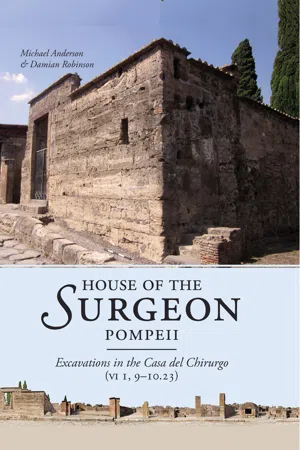
House of the Surgeon, Pompeii
Excavations in the Casa del Chirurgo (VI 1, 9-10.23)
- 528 pages
- English
- ePUB (mobile friendly)
- Available on iOS & Android
House of the Surgeon, Pompeii
Excavations in the Casa del Chirurgo (VI 1, 9-10.23)
About This Book
The House of the Surgeon represents the first major publication of an important series of excavations undertaken by the Anglo-American Project in Pompeii (1994-2006) at the ancient city of Pompeii in a city block known as Insula VI 1. This is one of the largest, most comprehensive, and most important sub-surface, pre-79 AD excavations ever to have been undertaken at Pompeii. The methodology employed to the systematic examination of an entire city block, involving extensive artefact and ecofact recovery, using the latest scientific methods, has generated one of the single largest bodies of archaeological data ever produced on the development of ancient Pompeii, from the earliest traces of human habitation until its destruction. The first major section of this data is now made available in form of a study of the most famous and prominent of the houses on the block. The Casa del Chirurgo (House of the Surgeon) has been one of the most frequently cited houses in the ancient city since its discovery in 1771. The results of the exhaustive study of the house within its urban context not only challenge many of the conclusions of previous research, but also make it possible at last for this important property to contribute information to the full history of Pompeii's urban development, illuminating the chronology of urban change, the processes involved in ancient domestic construction, aspects of the ancient environment, and changing socio-political and economic conditions within Italy throughout the middle to late Republic and early Empire.The House of the Surgeon represents the first major publication of an important series of excavations undertaken by the Anglo-American Project in Pompeii (1994-2006) at Pompeii in a city block known as Insula VI 1. This is one of the largest, most comprehensive, and most important sub-surface, pre-79 AD excavations ever to have been undertaken at Pompeii. The methodology employed has generated one of the single largest bodies of archaeological data ever produced on the development of ancient Pompeii, from the earliest traces of human habitation until its destruction. The first major section of this data is now made available in form of a study of the most famous and prominent of the houses on the block. The results of the exhaustive study of the Casa del Chirurgo (House of the Surgeon) within its urban context not only challenge many of the conclusions of previous research, but also make it possible to contribute information to the history of Pompeii's urban development, illuminating the chronology of urban change, the processes involved in domestic construction, aspects of the environment, and changing socio-political and economic conditions within Italy throughout the middle to late Republic and early Empire.
Frequently asked questions
Information
1
POMPEII’S INSULA VI 1 AND THE CASA DEL CHIRURGO
Michael A. Anderson and Damian Robinson
Introduction




The layout of the insula
Table of contents
- Cover
- Title
- Copyright
- CONTENTS
- Acknowledgements
- Preface
- Foreword: The Old Certainties are Crumbling: Rick Jones
- 1. Pompeii’s Insula VI 1 and the Casa del Chirurgo: Michael A. Anderson and Damian Robinson
- 2. The Anglo-American Project in Pompeii: Damian Robinson, Michael A. Anderson, H.E.M. Cool, Robyn Veal, and Charlene Murphy
- 3. Digging the Casa del Chirurgo: Michael A. Anderson and Damian Robinson
- 4. The Stratigraphic and Structural Sequence of the Casa del Chirurgo: Michael A. Anderson and Damian Robinson
- 5. Room by Room Discussion of Stratigraphy and Architecture: Michael A. Anderson and Damian Robinson
- 6. Glass Vessels and Small Finds: H. E. M. Cool
- 7. Report on the Coinage Recovered from the AAPP Excavations in the Casa del Chirurgo: Richard Hobbs
- 8. Plaster Fragments from the Cisterns of the Casa del Chirurgo: a window onto the house’s lost decoration: Helen White
- 9. Pavements of Mortar, Mosaic and Marble Inlay: Will Wootton
- 10. The Faunal Remains: Jane Richardson
- 11. Archaeobotanical Remains: Charlene Murphy
- 12. Fuel and Timber in the Casa del Chirurgo: Robyn Veal
- 13. The Ancient Campanian Environment and Results from the Casa del Chirurgo: Robyn Veal and Charlene Murphy
- 14 Conclusions: Michael A. Anderson
- Appendix I: Stratigraphic Unit Listing and Chapter 5 Concordance
- Appendix II: Harris Matrices for Areas Excavated
- Bibliography